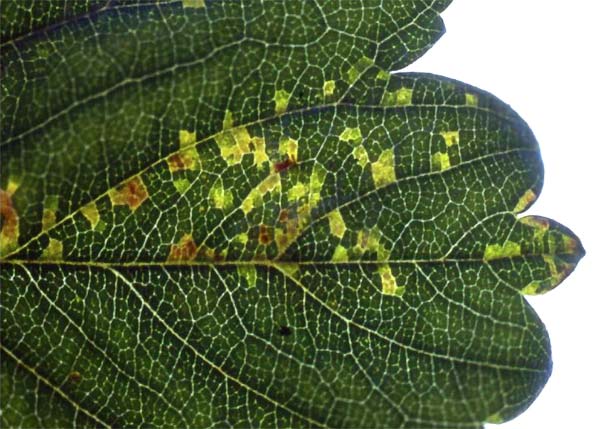Angular leaf spot is a bacterial disease commonly found in cucumbers, as well as squash, pumpkins, melons, and other cucurbits. Caused by the bacterium Pseudomonas syringae, the disease produces lesions on the leaves and fruit of infected plants. While the lesions on fruit are usually minor, they often enable secondary fungal and bacterial infections which rot the fruit.
Angular leaf spot disease produces water-soaked lesions—infected tissue dies and drops away, giving leaves a ragged shot-hole appearance.
The first symptoms of angular leaf spot disease appear in the form of small, watery lesions. Lesions initially appear on the undersides of leaves, near minor veins. These lesions may be tan, pale yellow or brown in color. The margins of the lesions are defined by the surrounding veins, giving them the flat edges and sharp corners which inspired the disease’s name. The lesions often have yellow halos, and may exude a milky white fluid. In some cases, the margins of leaves may also turn yellow (chlorosis).
Infected tissue becomes brittle, dies, and falls to the ground, giving leaves an almost moth-eaten appearance, with leaf edges becoming increasingly ragged.

In more severe cases, lesions form on stems and fruit. Fruit lesions are typically quite small and minor—forming tan, circular spots—and confined to fruit surfaces. However, these lesions eventually dry out, becoming chalky in appearance, and can crack and split. Secondary infections occur, with opportunistic fungi and bacteria colonizing exposed internal tissue, ultimately resulting in fruit rot.
Angular leaf spot is caused by a strain of the bacterium Pseudomonas syringae.
Growers familiar with Pseudomonas syringae most likely know it as the cause of bacterial canker. A specialized strain of the bacteria, Pseudomonas syringae pv. lachrymans, is the cause of angular leaf spot disease, having developed a specific affinity for cucumbers and other cucurbits.
Like its parent species, P. syringae pv. lachrymans is ubiquitous, and can be found throughout the United States due to its ability to overwinter in soil and infected plant debris. The disease cycle of angular leaf spot begins in spring, during rainy weather with temperatures rising above 75 degrees.
Infection typically occurs when rain, wind, pests, or farmworkers deposit the bacteria onto a plant leaf, which it subsequently invades through either pores or wounds in the leaf tissue. The disease can spread to seeds, and thus may be newly introduced into a field via infected seedstock.
As infected tissue and the fluid produced by leaf lesions drops away from the host plant to the ground below, bacteria are spread to nearby plants by farmworkers or equipment passing through the field (or natural phenomena), perpetuating the disease cycle.
Angular leaf spot is incurable—current treatment methods are largely limited to strategies for mitigating the spread of the disease.
There are many cucurbit varieties available which are marketed as being resistant to angular leaf spot. However, we have long noted that the poor nutrition and irrigation regimens, which make plants vulnerable to diseases like angular leaf spot, often compromise the touted disease-resisting characteristics of such varieties.
We advise that all growers, regardless of their selected plant varieties, should adopt practices which maximize the health and hardiness of crops, and discourage the reproduction and spread of P. syringae pv. lachrymans.
Such recommendations include:
- Avoid the excessive use of nitrogen fertilizer, as this encourages the rapid growth of weak tissues which are more vulnerable to infection and have decreased immune response.
- Implement a balanced nutrition regimen which incorporates the supplementation of boron and calcium, minerals that are critical in the growth of hardy, healthy plant tissue.
- Avoid excessive watering. Water-logged soils are favorable to the bacterium, and standing water makes it easy to splash the bacteria onto surrounding plants. Where possible, use drip irrigations systems, rather than overhead watering which can spread bacteria from leaf to leaf and plant to plant.
- Don’t work in fields while soils are wet. If parts of a field are known to be infected, work in those areas last in order to avoid spreading the disease to uninfected areas.
- Uproot, remove and destroy any plants showing symptoms of angular leaf spot. Surrounding plants should also be removed, as they may have already been infected but not yet symptomatic.
- Because syringae pv. lachrymans is specifically adapted to the biology of the plant family Cucurbitaceae, breaking the cycle of the disease requires rotating cucurbit crops out of infected fields. P. syringae can survive in decaying plant debris for more than two years—though using Fusion 360 Soil and Iota can accelerate the decay process—so the planting of cucurbits in infected fields should be avoided for at least three years.




